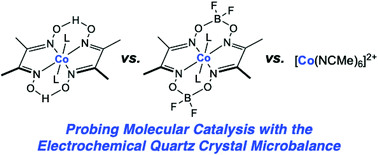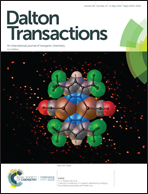Distinguishing deposition, corrosion, and stripping of transient heterogeneous materials during molecular electrocatalysis†
Abstract
Understanding the behavior of molecular hydrogen-evolving electrocatalysts is often challenging, because secondary heterogeneous materials can form during reductive electrode polarization and contribute to catalysis. Here, we use an electrochemical quartz crystal microbalance to interrogate secondary heterogeneous materials formed in situ during hydrogen generation with the proton- and difluoroboryl-bridged dimethylglyoxime cobalt catalysts in acetonitrile electrolyte. Detrimental protonation reactions of the molecular precatalysts lead to formation of the transient heterogeneous materials, and the structure of the molecular cobaloxime precursors affects the potential dependence and kinetics of deposition and loss of heterogeneous material from the electrode surface. The strength of the acid in the electrolyte (needed as the proton source for H2 generation) also contributes to the stability and corrosion rate of the heterogeneous materials, as revealed in multistep polarization studies. Overall, these results support involvement of an interplay of electrodeposition, proton-driven (chemical) corrosion, and anodic (electrochemical) stripping in influencing the catalytic activity and the behavior of transient heterogeneous materials that may be generated during catalysis.



 Please wait while we load your content...
Please wait while we load your content...